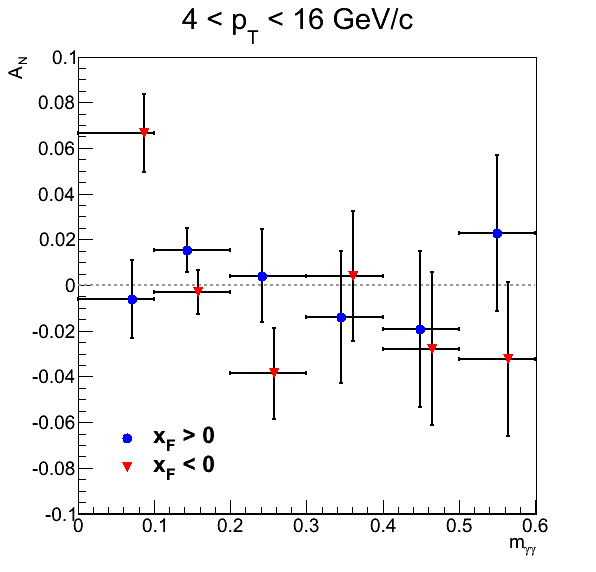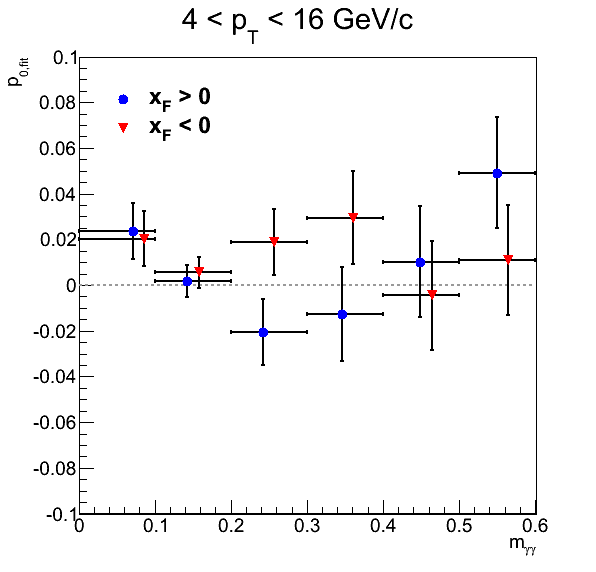- drach09's home page
- Posts
- 2022
- 2020
- June (1)
- 2019
- 2018
- 2017
- 2016
- 2015
- 2014
- December (13)
- November (2)
- October (5)
- September (2)
- August (8)
- July (9)
- June (7)
- May (5)
- April (4)
- March (4)
- February (1)
- January (2)
- 2013
- December (2)
- November (8)
- October (5)
- September (12)
- August (5)
- July (2)
- June (3)
- May (4)
- April (8)
- March (10)
- February (9)
- January (11)
- 2012
- 2011
- October (1)
- My blog
- Post new blog entry
- All blogs
2006 EEMC Neutral Pions: Transverse SSA as a Function of Invariant Mass
The main obstacle between here and a preliminary result for AN is the background subtraction. It has been decided that for the time being, I will work on a "traditional" background correction while Steve works to stabilize his method. One sensible first step is to examine the asymmetry as a function of invariant mass. This also serves to satisfy a question raised by Elke at the analysis meeting. She had questioned whether or not the low-mass background is indeed spin-independent and whether or not we had analyzed the asymmetry for mγγ < 0.1 GeV/c2.
Figure 1: AN vs. mγγ
 |
 |
Figure 1 shows AN as a function of invariant mass. One sees that for xF > 0, the asymmetries everywhere, including below 0.1 GeV/c2, are quite small. There appears to be a "bump" around the pion mass, though the effect is quite small statistically speaking. A constant fit to the xF > 0 points is actually too good: 0.0070±0.0072 with χ2/ν = 2.674/5. A constant fit to the corresponding p0's is probably not good enough: 0.0044±0.0051 with χ2/ν = 9.72/5.
More troubling to me is the behavior for xF < 0. For the bin below 0.1 GeV/c2 there is a 3.9σ effect around 7%. A constant fit to the asymmetry points yields 0.0029±0.0071 with χ2/ν = 20.77/5. A similar fit to the p0 points yields 0.011±0.005 with χ2/ν = 2.751/5. Also, I note that five of six points sit above the horizontal.
Figure 2: Asymmetry Fits in Mass Bins (xF > 0)
| 0.0 < mγγ < 0.1 GeV/c2 |
|---|
 |
| 0.1 < mγγ < 0.2 GeV/c2 |
 |
| 0.2 < mγγ < 0.3 GeV/c2 |
 |
| 0.3 < mγγ < 0.4 GeV/c2 |
 |
| 0.4 < mγγ < 0.5 GeV/c2 |
 |
| 0.5 < mγγ < 0.6 GeV/c2 |
 |
Figure 3: Asymmetry Fits in Mass Bins (xF < 0)
| 0.0 < mγγ < 0.1 GeV/c2 |
|---|
 |
| 0.1 < mγγ < 0.2 GeV/c2 |
 |
| 0.2 < mγγ < 0.3 GeV/c2 |
 |
| 0.3 < mγγ < 0.4 GeV/c2 |
 |
| 0.4 < mγγ < 0.5 GeV/c2 |
 |
| 0.5 < mγγ < 0.6 GeV/c2 |
 |
- drach09's blog
- Login or register to post comments
